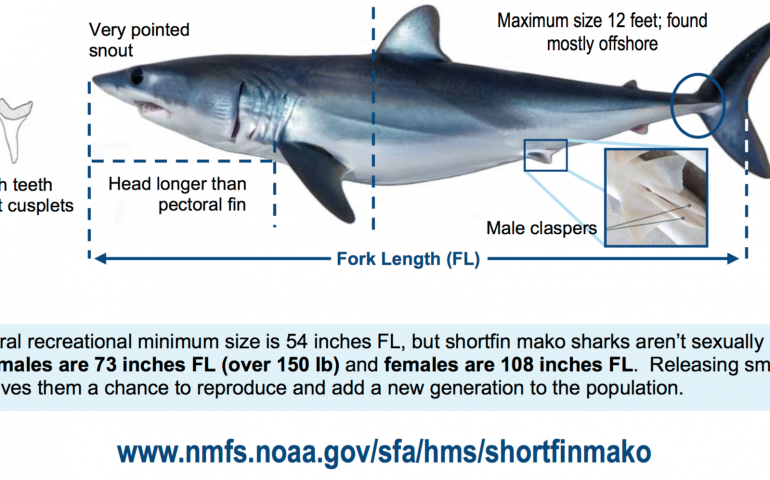Species: Isurus oxyrinchus (Rafinesque, 1810); from the Greek word isurus (equal and tail) and the Greek word oxyinchus (sharp snout).
Alternate Names: Mako is the work used by the Maori in New Zealand to describe sharks, but this is another shark with many names. In California it’s often called bonito shark, mackerel shark or simply mako. Also called blue pointer, blue dynamite, paloma, spriglio, sharp-nosed shark, pointed-nose shark, and snapper shark (Australia). Called Tiburón marrajo in Mexico.
Identification: Body more slender than great white. A long, conical-shaped snout with the 1st dorsal fin beginning or slightly behind the rear corner of the long pectoral fin; 2nd dorsal fin small, beginning slightly ahead of the anal fin. A prominent keel on the sides of the caudal peduncle extending from the tail to a point above the pelvic fins. Dark gray or metallic-blue above and on the sides (fading to gray after death), white below. Has a black spot at the base of the pectoral fin. Fang-like, non-serrated teeth.
Size: To 19.2 feet and over 1,530 pounds; a mako caught by commercial fishermen in Massachusetts in 1997 weighed 1,530 pounds—after being gutted. Most makos seen in California are 6-8 feet long. The California angling record fish weighed 1,098 pounds 12 ounces and was taken at Anacapa Island in 2010. The diving record fish weighed 484 Lbs 4 oz and was taken at San Diego in 2017.
Range: Circumglobal in tropical and temperate seas. Gulf of California to British Columbia but uncommon north of Columbia River, Oregon.
Habitat: Typically found in the open ocean in the epipelagic, aka sunlit or euphotic zone, the top layer of the ocean zones. However, often found down to about 500 feet deep and recorded down to 2,460 feet. Occasionally ventures inshore where they may become a target of pier rats. Primarily feeds on pelagic schooling species such as mackerel, sardines, bonito and tuna, but also will eat squid, other sharks (incluuding blue sharks and hammerheads), dolphin, and even billfish; mako are considered apex predators.
Piers: Uncommonly seen at piers but several have been reported from Santa Monica Bay piers—Hermosa Beach Pier, Manhattan Beach Pier, Venice Pier and the Santa Monica Pier. Makos have also been reported from the Imperial Beach Pier, Oceanside Pier, San Clemente Pier, Huntington Beach Pier, and Belmont Pier.
Shoreline: Rarely seen by shore-bound anglers.
Boats: A frequent goal of boaters in southern California but fairly big game tackle is required.
Bait and Tackle: Taken on live bait, especially live mackerel. Will also hit trolled mackerel and lures. Usually taken in deeper water with hooks size 6/0-10/0. Makos are the fastest swimming sharks reaching a sustained swimming speed exceeding 22 mph and spurts of nearly 50 mph. They are considered a top sportfish displaying torpedo-like speed and often leaping like a billfish when hooked.
Food Value: One of the best tasting sharks. It has a mild flavor with large flakes and a very firm (dense) texture. All methods of cooking are acceptable. According to Raymond Cannon in his excellent book How to Fish the Pacific Coast, “thousands of pounds of bonito shark were sold during the meat scarcity in city markets and served in restaurants as ‘swordfish’ and ‘sea bass’ at fresh-fish prices.”
Comments: Richard Ellis in his excellent book, The Book of Sharks, writes, “The mako is the quintessential shark. It is probably the most graceful of all sharks, the most beautifully proportioned, the fastest, the most strikingly colored, the most spectacular game fish, and one of the meanest-looking animals on earth.”
